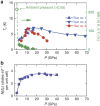Pressure-driven dome-shaped superconductivity and electronic structural evolution in tungsten ditelluride
- PMID: 26203922
- PMCID: PMC4525151
- DOI: 10.1038/ncomms8805
Pressure-driven dome-shaped superconductivity and electronic structural evolution in tungsten ditelluride
Abstract
Tungsten ditelluride has attracted intense research interest due to the recent discovery of its large unsaturated magnetoresistance up to 60 T. Motivated by the presence of a small, sensitive Fermi surface of 5d electronic orbitals, we boost the electronic properties by applying a high pressure, and introduce superconductivity successfully. Superconductivity sharply appears at a pressure of 2.5 GPa, rapidly reaching a maximum critical temperature (Tc) of 7 K at around 16.8 GPa, followed by a monotonic decrease in Tc with increasing pressure, thereby exhibiting the typical dome-shaped superconducting phase. From theoretical calculations, we interpret the low-pressure region of the superconducting dome to an enrichment of the density of states at the Fermi level and attribute the high-pressure decrease in Tc to possible structural instability. Thus, tungsten ditelluride may provide a new platform for our understanding of superconductivity phenomena in transition metal dichalcogenides.
Figures





References
-
- Ali M. N. et al.. Large, non-saturating magnetoresistance in WTe2. Nature 514, 205–208 (2014). - PubMed
-
- Cai P. L. et al.. Drastic pressure effect on the extremely large magnetoresistance in WTe2. Preprint at http://arxiv.org/abs/1412.8298 (2014). - PubMed
-
- Pletikosić I., Ali M. N., Fedorov A. V., Cava R. J. & Valla T. Electronic structure basis for the extraordinary magnetoresistance in WTe2. Phys. Rev. Lett. 113, 216601 (2014). - PubMed
-
- Wang Q. H., Kalantar-Zadeh K., Kis A., Coleman J. N. & Strano M. S. Electronics and optoelectronics of two-dimensional transition metal dichalcogenides. Nat. Nanotechnol. 7, 699–712 (2012). - PubMed
-
- Chhowalla M. et al.. The chemistry of two-dimensional layered transition metal dichalcogenide nanosheets. Nat. Chem. 5, 263–275 (2013). - PubMed
LinkOut - more resources
Full Text Sources
Other Literature Sources

